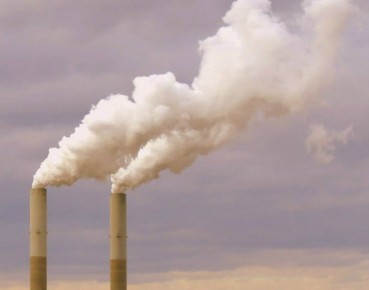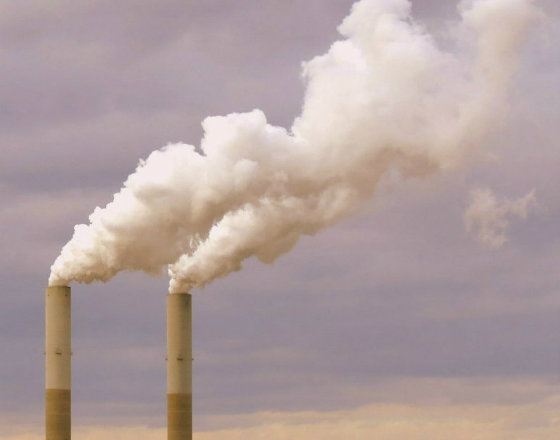Tydzień w gospodarce
Category: Trendy gospodarcze

(Brent Moore, CC BY-NC)
According to the think tank Climate Action Tracker, the global emissions of carbon dioxide from fossil fuels and industry will probably fall by about 4 to 11 per cent in 2020. The trend could be similar in 2021. In the European the electricity generation system alone CO2 emissions decreased by up to 39 per cent in April, even though this was solely the effect of a 14 per cent drop in demand for energy. Of course, this is a short-term effect of the lockdown, and in the long run, after the pandemic ends, emissions could actually increase. Analysts point out that if the governments fail to implement low-carbon growth strategies in the face of the coming crisis, then emissions could increase and even exceed the previous forecasts by 2030. Meanwhile, at the beginning of 2020 the World Economic Forum stated that climate change is the most serious threat to humanity and that by 2100 its consequences would cause a permanent 7 per cent decline in global GDP.
The number of experts claiming that the recovery from the economic stagnation caused by the coronavirus pandemic should be supported with investments in energy-efficient buildings, electromobility and renewable energy, is increasing. In April, 13 European climate and environment ministers from countries representing 83 per cent of the European Union’s GDP (including France, Germany, and Italy), as well as 180 politicians and social leaders, including the CEOs of Ikea, H&M, Lego and Microsoft, published a letter in which they pointed out that the economic stimulus packages should be focused on pro-environmental solutions and should accelerate the green transition. The Green New Deal was a key element of the political program of the Democratic Party, which has just won the elections in South Korea and wants to take advantage of the European Union’s experiences in this area. Moreover, in May 2020, a group of 1200 investors from around the world affiliated in the Investor Agenda platform — together managing USD35 trillion in assets — issued a special statement on climate change. In the document they called on governments to use their stimulus programs in order to promote sustainable development and the fight against inequality, to accelerate the transition to the net-zero emissions economy, to create new jobs, and to activate private capital in the implementation of environmentally sustainable solutions.
Similar statements were published by the UN Secretary-General António Guterres and the Executive Director of the International Energy Agency Fatih Birol, who compared the current situation with the previous global financial crisis. Compared with the recession of the 1930s, the public sector was much more developed during the financial crisis of 2008-2012. This allowed for the utilization of a wide range of monetary and fiscal policy instruments in order to save the economy. In these extraordinary conditions, some of the developed countries tried to seize the opportunity in order to implement policies responding to the climate challenges, among others, through public investments in improving energy efficiency or co-financing of renewable sources of energy. The so-called green fiscal stimulus (an average of 16 per cent of the funds globally were allocated on investments related to climate protection) have had the desired effect, translating into new jobs and GDP growth. “At the same time it proved to be ineffective as a tool of climate policy, mainly due to the lack of mobilization of all stakeholders and the lack of developed paths for the decarbonization of the energy mix,” stressed Fatih Birol.
Indeed, the CO2 emissions fell by 400 million tons in 2009, but in 2010, after the launch of stimulus packages, they increased by 1.7 billion tons, mainly in Asia. “We need to learn from what happened then in order to make smart policy decisions regarding the economic recovery after the pandemic, so that we can put emissions on a path of structural decline this decade,” added the head of the International Energy Agency.
All these calls coincided with the publication of the results of studies conducted by a team headed by Joseph Stiglitz and Nicholas Stern. The researchers evaluated the potential economic and environmental effects of a “green path” towards recovery after the pandemic. They analyzed more than 700 stimulus packages and interviewed 231 experts from 53 countries. The researchers found out that green projects generate more jobs, are more cost-efficient and lead to increased long-term savings compared with traditional fiscal packages.
For now, all eyes are on the European Union, whose recovery package for the economy will amount to EUR540bn in the form of grants and loans. Approximately EUR300bn will go to the member states as part of the SURE initiative (EUR100bn) and on guarantees of job protection or the deferment of social insurance contributions, while EUR200bn will be provided for loan guarantees offered by the European Investment Bank. In mid-April 2020 the European Parliament appealed to the European Commission to present a recovery plan for the European economy, which would be based on the European Green Deal and digital transformation. This relates to the EU strategy for economic growth proposed back in 2019, which aimed to transform the EU into “a fair and prosperous society,” where there are no net emissions of greenhouse gases in 2050 and where economic growth is decoupled from resource use. All the relevant EU laws and policies were supposed to be consistent with the goal of climate neutrality. The aim of such an enormous commitment is not only to meet the global climate objectives of the 2015 Paris Agreement, which sought to limit the global temperature increase to 1.5°C compared to the pre-industrial era, but also to put pressure on the other global players, such as the United States, China or Russia, to take similar steps.
At the outbreak of the pandemic it seemed that it would be necessary to change all the rules of the game in order to save the economy, and thus the societies, from a total collapse. At any cost, including that of climate protection. Especially considering, that the European Green Deal covered all sectors of the economy: transport, energy, agriculture, buildings, and industries such as steel, cement, ICT, textiles, and chemicals. However, during its April meeting the European Council announced, that “the roadmap for the recovery” should be consistent with the Green Deal. Moreover, the European Council continues its legislative works on the European Climate Pact.
What does this mean in practice? Given that the implementation of the objectives within the area of climate and energy assumed additional investments in the amount of EUR260bn per year, or about 1.5 per cent of the European Union’s GDP in 2018, it can be expected that these investments will now be implemented directly and indirectly as part of the coronavirus rescue program.
In their report „Recovering Better: A Green, Equitable and Resilient Recovery from Coronavirus”, Michael Jacobs, Laurie Laybourn-Langton and Michael Davies from the Economic Change Unit emphasize that it is crucial to develop the appropriate conditions for the provision of assistance. For example, in the aviation sector, any subsidies should take into account the future taxation of fuel, which currently does not apply to this sector.
The assistance should not be focused on subsidizing renewable energy sources, which are already cost-competitive in relation to conventional energy, but on providing funds for closing down facilities using fossil fuels, for energy storage systems, and for hydrogen technologies. Most importantly, in addition to the EU level, individual countries must develop their own policies for using the national stimulus packages in a green and sustainable way.
In Poland, the available options were presented at the beginning of May 2020 by Instrat — Foundation for Strategic Initiatives in their report “The Green Fiscal Package”. The authors of the report believe that the Green Fiscal Package should focus on the thermo-modernization of single-family houses and individual heating systems, as well as the development of renewable energy sources, including microgeneration. Such investments bring the highest number of jobs in the short term and are also compatible with the existing state policies, which allows for the extension of the current assistance programs (such as “Clean Air” and “My electricity”) instead of establishing new ones. The authors argue that the Public Investment Program proposed by the government, which amounts to PLN30bn (EUR6.8bn), is insufficient given the enormity of the challenge. Therefore, in order to finance the Green Fiscal Package, Poland should launch the issue of green bonds and sustainable bonds, especially since EU regulations facilitate such actions.
“EU regulations determine in a very detailed way the activities which can be considered sustainable in the light of the European climate policy. And although they are still at the fledgling stage, it is worth adapting all investments developed under the Public Investment Program to these regulations to the greatest extent possible. This will prevent the allocation of funds for infrastructure which will not receive the green stamp of the EU in the future and, consequently, will not be eligible to receive funding from the EU budget,” stated the authors of the report.
Local governments can also join the financing of green fiscal packages by issuing their own green and sustainable bonds. Some of the bonds could be targeted to the local communities in the form of retail instruments with low face values. Such a solution was used, among others, by the city of Swindon in the United Kingdom, which offered its residents “solar bonds” worth GBP1.8m. The raised funds were used for the construction of a photovoltaic farm with a capacity of 5 MW for local needs.
Local governments have already started introducing “green packages” without waiting for the implementation of the assistance programs. Many cities, including Milan, Paris, or Barcelona, have announced their plans aimed at providing the residents with secure and environmentally-friendly ways to travel through the urban spaces in the new reality, in which physical distancing will be the norm. This means that many kilometres of new bicycle paths and pedestrian walkways will be built.
Mayors of cities from Europe, United States and Africa, participating in the C40 initiative, have discussed the possibility of cooperation for the promotion of a lasting, low-carbon, post-crisis recovery. These talks are taking place at a time when four EU member states — including Germany — are delaying the submission of their national energy and climate plans (NECPs) to the European Commission. There are also opinions that since deglobalization processes will take place and some of the production activities will return to Europe, then the level of emissions will increase. However, the reality is that by exporting the high-emission manufacturing to plants located in China, we contributed to the global emissions growth. Meanwhile, by moving some manufacturing back to modern, low-emission plants in Europe, we would contribute to a global reduction in CO2 emissions and to the creation of new jobs. Ultimately, this would be the optimal outcome from the implementation of the Green Deal.

